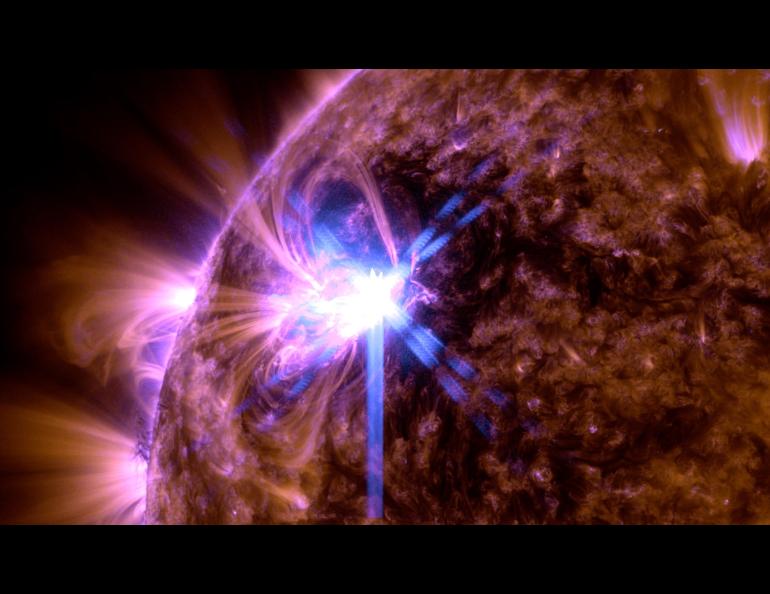Two rockets are set to launch within minutes of each other from Poker Flat Research Range this month in NASA’s first campaign to study solar flares with instruments launched on sounding rockets.
The launches, which will occur in the daytime, could occur any day. The launch window runs for two weeks.
The launch countdown will begin just before noon and then hold at 3 minutes. The count will resume when science leaders detect a desired solar flare. The count will terminate if no suitable flare is detected after four hours. The process will repeat daily until a launch occurs or the two-week window closes.
The University of Alaska Fairbanks Geophysical Institute owns Poker Flat, located at Mile 30 Steese Highway, and operates it under a contract with NASA’s Wallops Flight Facility, which is part of the Goddard Space Flight Center.
Poker Flat launch updates via text are available by typing PFRRLAUNCHES to 866-485-7614.
The two launches will gather data for heliophysics research and validate new science instruments. Heliophysics deals with the study of the sun and its effects on the solar system, including the Earth and other bodies.
A NASA white paper calling for creation of a solar flare research effort by sounding rocket said new instruments “would immediately lead to advances in flare science via multiwavelength observation of a single flare.”
Scientists want to launch when the sun emits a medium or large solar flare, and Poker Flat provides greater flexibility because of its location in a sparsely populated region and its ability to allow lengthy launch periods compared with White Sands.
A solar flare is an intense eruption caused by the release of magnetic energy stored in the sun's atmosphere. Solar flares typically occur in active regions on the sun’s surface, such as sunspots, where magnetic fields are particularly strong.
The total energy released during a solar flare can vary widely, but even moderate-sized flares can release energy equivalent to millions of megatons of dynamite.
The two missions have each had prior launches, with improvements to instruments occurring each time.
• FOXSI-4: The Focusing Optics X-ray Solar Imager mission is led by Lindsay Glesener, an associate professor at the University of Minnesota Institute for Astrophysics.
The most recent of the FOXSI program’s three prior launches occurred in 2018. FOXSI is the first solar-dedicated instrument to observe hard X-rays using focusing optics. Hard X-rays have higher energy and better object penetration, making them suitable for imaging dense materials. Soft X-rays have lower energy and are best used for surface imaging.
“Direct imaging enables the experiment to study solar radiation with enhanced sensitivity and dynamic range, exploring issues of energy release and particle acceleration in the corona — the outermost layer of the sun,” the University of Minnesota’s FOXSI website states.
• Hi-C: The High-resolution Coronal imager mission is led by astrophysicist Sabrina Savage of NASA’s Marshall Space Flight Center. This will be the third launch in the Hi-C program, following launches in 2012 and 2018.
The Hi-C instrument will seek more information about the dynamics of the sun’s corona, which extends millions of miles into space.
“Our flight data demonstrate that at 150-kilometer resolution we are at or near the scale size of coronal structures, and our 5-minute data set provides tantalizing clues for the outstanding science capabilities of this next generation in astrophysical instrumentation,” NASA’s Hi-C website states.
Both missions capitalize on the sun’s increased activity as it nears the high point of its 11-year cycle. This period of heightened activity, known as solar maximum, is characterized by increased sunspots, solar flares and coronal mass ejections, or CMEs.
Sunspots are dark areas on the surface of the sun caused by intense magnetic activity. Coronal mass ejections are massive eruptions of plasma and magnetic field lines and can interact with our planet’s magnetosphere, potentially causing geomagnetic storms and auroras.
Increased solar activity during solar maximum can affect space weather, which can impact satellite communications, GPS systems, power grids and even astronauts in space. Geomagnetic storms triggered by CMEs can disrupt communication and navigation systems and induce electrical currents in power grids, leading to blackouts.



